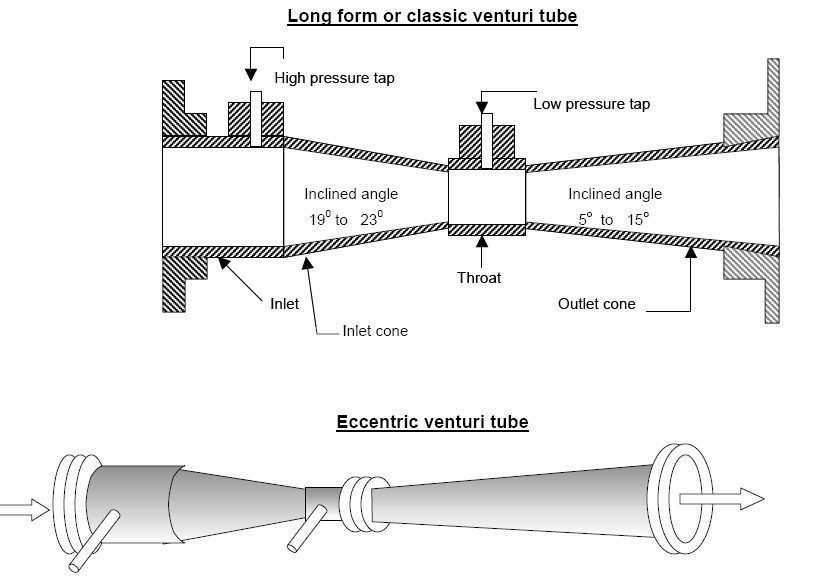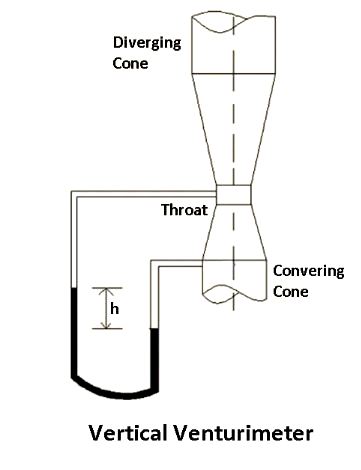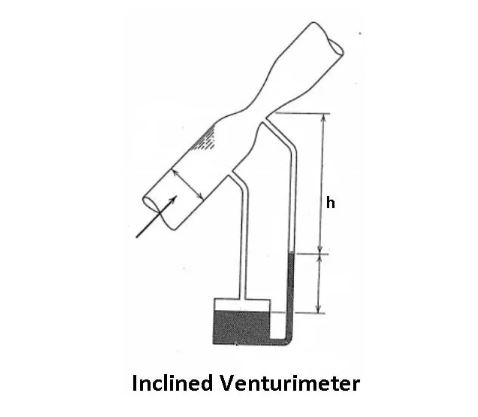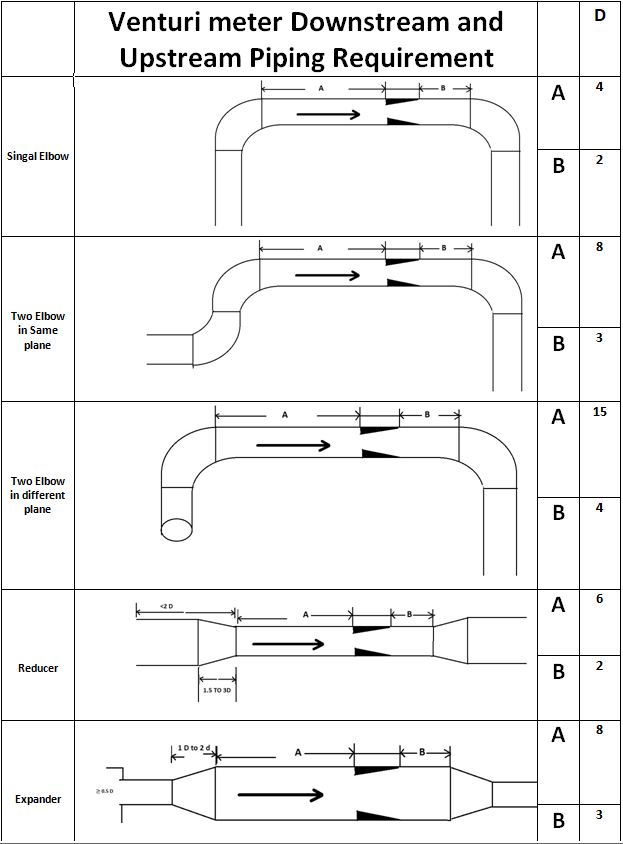Table of Contents
Venturimeter is a type of flowmeter which works on the principle of Bernoulli equation. This instrument is widely used in the water, chemical, pharmaceutical, oil and gas industries to measure the flow rate of a fluid inside a pipe. The pipe cross-sectional area is reduced to create a pressure difference which is measured with a manometer to determine the rate of fluid flow. Venturi meter is a differential head type flowmeter which converts pressure energy into kinetic energy. The principle of the venturimeter was demonstrated by Giovanni Battista Venturi (hence the name venturimeter), but it was first used in practical metering applications by Clemens Herschel. In this article, we’ll explore the parts, working principles, equations, and applications of the venturimeter.
What is venturimeter?
When permanent pressure loss is primary importance in head flow measurement, the venturi tube deserves strong the velocity head and decreasing the pressure head. The flow rate remains statics in the throat section where there in no cross sectional dimensional change, but it decreases in the recovery section and the decrease velocity head is recovered as pressure. The relatively large recovery at this point results in a permanent pressure loss of any 10 to 25 % of the differential pressure across the tube.
When large lines with high flow rates are involved, substantial savings in power requirement can be obtained.
The venturi tube can be use to handle any fluid that contains some solids because it contain no sharp corners nor project into the fluid stream. Slurries and dirty liquid that hold up around other primary devices can be handled easily if the pressure taps are protected from plugging.
The classical venturi tube consists of a converging conical inlet section, a cylindrical throat and diverging recovery cone. Fluid velocity increases in conversing inlet section, increasing The over all accuracy of the venturi tube is better than orifice plate, it may range from +/- ¼ to +/- 3%. a venturi coefficient is less effected by a decreasing Reynolds number than a nozzle or an orifice. therefore, more accurate over wide flow range.
Venturimeter Diagram

Parts of venturimeter
- Cylindrical inlet section: Venturimeter inlet is a straight cylindrical section whose length is equal to 5 to 8 times the diameter of the pipe.
- Convergent conical section: In this section, the venturi meter tube diameter is gradually reduced. The conical angle is normally 210 ± 20. While the liquid flows inside the venturimeter, the velocity of the fluid increases at the expense of a decrease in pressure.
- Cylindrical Throat: Throat has minimum ventrometer diameter. In the larynx, the velocity is maximum and the pressure is minimum. Typically, throat diameter = 1/3 to 1/4th of the inlet pipe diameter.
- Diverging conical section: On this section of the venturimeter, the diameter of the tube gradually increases. So, the pressure builds up again to the original inlet pressure. The cone angle is 5-70. British Standard BS-1042 specifies two conical angles, 5-70 and 14-150, for the outlet cone.
Material Of Venturi meter
Smaller venturimeters are made of brass, glass or bronze and larger venturimeters are made of cast iron, steel or stainless steel.
Working principle of venturimeter
A fluid accelerates in the convergent part and then decelerates in the divergent section as it passes through a venturimeter. A manometer measures the pressure difference between an upstream part and the throat. The volumetric flow rate can be determined using that differential pressure, Bernoulli’s Equation, and the Continuity Equation.
Types of Venturimeters
There are three types of venturimeters available:
-
Horizontal Venturimeter:
kinetic energy of this type venturimeter is high and potential energy is low. A horizontal venturimeter with an inlet diameter of 200 mm and a throat diameter of 100 mm is used to measure water flow.





-
Vertical Venturimeter:
potential energy of this type venturimeter is high and kinetic enery is low.





-
Inclined Venturimeter:
potential and kinetic energy are in between the above two types mentioned.





Applications of Venturimeter
Venturimeters are widely used in fluid industries. The major application of venturimeters include :-
- Venturimeter used to measure air flow in Engine Carburetors (Automobile Sector) .
- Venturimeter used to measure and control process flow in process industries (Process and Power Piping Industries).
- Blood flow in the arteries is measured by venturimeters In the medical industry,
- fluid flow inside pipelines (Oil & Gas Industries) is measured by venturimeter.
Codes and Standards of Venturi meter
The codes and standards that provide guidelines related to venturi meters are
- ISO 5167
- ISO 9300
- AWWA M33
- ISO TR 15377
- BS 1042
- ASME MFC-8M
- ASTM D2458
- AGA 9
Installatiion of venturimeter
The Venturi meter’s installation is essential to its optimal performance. As a result, venturi metres should be installed according to the manufacturer’s instructions. When installing venturi metres in piping or plumbing systems, the following guidelines should be followed:
- The venturi meter’s flow direction arrow should be examined and installed to match the flow direction.
- The Venturi meter’s flanges at the ends must be appropriately aligned with the piping flanges.
- On a Venturi metre, no pipe support should be fitted.
- Bolts must not be torqued excessively.
- Tolerances for installation should be within industry standards.
- For liquid service applications, pressure taps should be oriented horizontally.
Venturi meter Upstream and Downstream Pipe Straight Leg Requirement
For proper functioning and accurate results, the flow through the venturi meter must be constant. This requires a minimum straight pipe length upstream and downstream of the Venturi meter. The straight leg requirement varies depending on the type of fitting, the type of venturi meter, and the beta ratio (throat diameter divided by inlet diameter). The following image provides a sample table that provides typical power foot requirements when installing a venturi meter in a piping system.





Advantage of venturimeter
- Causes low permanent pressure loss.
- Widely used for high flow rate.
- Available in very large pipe sizes.
- Has well known characteristics.
- More accurate over wide flow range than orifice plate or nozzles. 6. Can be used at high and low beta ratios
Disadvantage of venturimeter
- High cost.
- Generally not use full below 76.2 mm pipe size.
- More difficult to inspect due to its construction
- Limitation of lower Reynolds number of 150000, (some data is however
- Available down to Reynolds number of 50000 in some sizes).
- Calculated calibration figures are less accurate than for orifice plates.
- For greater accuracy, each individual Venturi tube has to be flow calibrated by passing known flows through the Venturi and recording the resulting differential pressures.
- The differential pressure generated by a venturi tube is lower than
- for an orifice plate and, therefore, a high sensitivity flow transmitter
- is needed.
- It is more bulky and more expensive.
- As a side note; one application of the Venturi tube is the measurement of
- flow in the primary heat transport system. Together with the temperature
- change across these fuel channels, thermal power of the reactor can be calculated.
Read Also